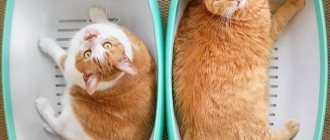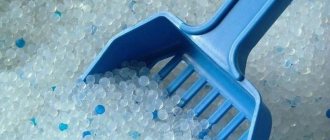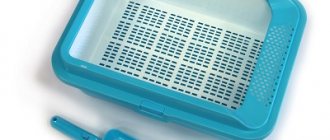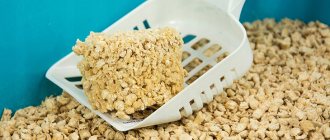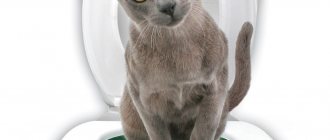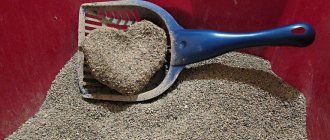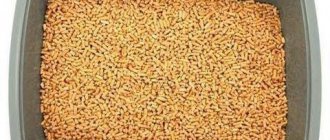How to choose a litter box for cats
When an owner chooses a toilet for a pet, he must think through all the details for his own and the cat’s convenience. After all, it will depend on whether the pet will go into it and whether it will be convenient to clean it. When choosing a litter box for your cat, you should first pay attention to the following parameters:
- The relationship between the size of the animal and the future toilet. Often, owners of kittens buy a tray for growth, and the animals suffer while overcoming the high sides.
- Pet's love of digging. This parameter will depend on: the weight of the tray - a heavy toilet is more difficult to move when moving the paws;
- the use of filler necessitates the selection of a special tray;
- purchasing a mat - some owners use this accessory so that the cat, when leaving the toilet, leaves granules stuck to its paws on it.
- absence of odor - in case of frequent departures of the owner from the house, an unpleasant aroma will appear from the cat litter placed in the center of the home, no matter what filler is used;
Now that the owner has created a project for the upcoming purchase in his head, let’s look at the types of trays and their differences.
Preparing “toilet paper”: what is the difference between popular fillers
The cat is clean and smart, it does not need to be toilet trained, just show it once where the tray is. But in order to behave well, she must be provided with everything necessary. An important point: even a tray with high sides should preferably be located in a quiet and secluded place where the animal will have constant access.
Why is the choice of filler so important? Feces and bacteria parasitizing on cat urine have a very unpleasant odor. And this becomes a problem for kitten owners. Although, a completely solvable problem:
- You can choose a flat tray with pallet inserts. Now such cat litters are sold in any pet store.
- Purchase a scented litter that allows you to maintain a fresh smell from the moment of defecation until cleaning the toilet.
- Give preference to clumping litters.
In the first option, no filler is provided at all. But the owner is forced to wash the tray several times a day. What if there are several animals and each of them needs its own tray? After all, cats try to avoid other people’s smells and will not go to the same “potty.”
The only dubious advantage in this case is the low cost of the tray and the absence of the need to buy granules. But the disadvantages are more obvious: labor intensive and the constant smell of cat litter.
The second and third options are more acceptable for a kitten, although they require the purchase of more expensive trays with different design features - high sides, lack of a plastic mesh pallet. But the main detail is the hygienic filler, which you also cannot buy at random; you need to carefully select it.
Types of cat litter
Of course, in terms of frequency of cleaning, litter trays are optimal. But hygiene in this case is achieved solely due to the quality of the granules. There are the following types of cat litter:
- Mineral. Doesn't stick to paws. Suitable for kittens. Absorbs smell well until it gets completely wet.
- Woody. Has a natural composition. The most inexpensive type of filler.
- Silica gel. Antibacterial, has the highest absorbency. Makes a loud rustling noise that can frighten kittens.
- Clay (clumping). Easy to clean. Economical to use.
Photo gallery: litter granules for cat litter boxes
An environmentally friendly composition is used to produce mineral filler
Wood filler has a pine smell
Silica gel filler can be harmful if swallowed and is therefore contraindicated for inquisitive animals.
The best option in terms of absorbency, price and presence of dust is a clay filler.
HOW TO REMOVE THE TRAY AND HOW OFTEN TO CHANGE THE FILLER?
Cats have a habit of peeing in the same corner of the tray over and over again. If you are too lazy to remove the grill and remove the stuck together lump of filler, just unfold the tray.
If necessary, remove the grill, remove lumps and add fresh filler.
When using silica gel, the tray container can be washed rarely - once every two to three weeks, as needed. But it would be a good idea to wash the grate after each trip “for the most part.”
How to care for your cat's litter box
If you have a tray with a low side, then after cleaning the waste into the toilet, you can simply wash it using a brush and detergent to disinfect it.
We have just such a tray at home and two active users. Therefore, every evening we simply flush the waste into the toilet and flush the toilet with hot water, thoroughly cleaning the mesh with a brush. After this, leave some water at the bottom and add Domestos, distribute the resulting mixture along the bottom in a circular motion and return the tray back to the toilet. Thanks to this method, the liquid contents of the cat's litter box do not begin to smell by the evening (we work and there is no way to rinse the litter box after each visit to the animals), and bacteria do not begin to multiply. My pets have been living with the family for more than 12 years, and no pathologies associated with chemicals in the tray have been noticed. However, this method cannot be used if a kitten lives at home, since the composition of the cleaning product can damage the delicate pads of the paws.
If you use filler, then general cleaning is done less frequently, but in a more complex way. Daily cleaning includes the destruction of solid waste, and for complete cleaning you will need to remove the used granules and rinse the tray:
- For the first stage, it is convenient to use a bag with thick walls. Place it over one edge of the tray and pour the used granules into it.
- Then, using a scoop, scoop the remaining stuck litter into the bag and tie it tightly.
- Wash the tray using cleaning products.
- Blot up any excess water with a paper or regular towel.
- Add fresh filler.
Why is there a mesh in the cat tray?
Among the wide range you can choose rectangular, oval and corner models. With a door, a carrying handle, even a carbon filter. It is advisable that the chosen “nook” for the cat be equipped with a special mesh.
The main purpose of the grill is to protect the animal from dirt. Liquid excrement seeps through the mesh. Hard ones will remain on top: just pull out the removable part and rinse under running hot water.
Many owners choose containers without a mesh, justifying the purchase based on the cat’s physiology:
- It’s inconvenient to drive your claws across plastic;
- feces remain on the mesh - which means the cat will still get its paws dirty, trying to bury the waste.
Then they are forced to buy a removable side that prevents the animal from scattering sand or granules, and a small rug on which the pet wipes its paws. Another reason to choose a litter box with mesh is that the mesh will prevent your cat from eating the kibble.
How to toilet train a cat
If you just took your pet into the house, you can teach him to relieve himself in the tray or even directly in the toilet.
Mastering the tray
There will be no difficulties when training a cat to use a litter tray if you follow simple rules:
- choose a tray that is suitable in size;
- be patient and pay as much attention as possible to your pet during this difficult period;
- generously praise the animal for every successful act and gently reprimand for mistakes.
You should definitely take some litter or newspaper from the previous owner, on which the pet has already relieved itself, and put it on the bottom of the tray so that the cat can identify the place by smell at first.
Some owners practice the one-room principle, when the animal is locked in a room where it has everything it needs to live, and is kept there for several days after adoption. It is believed that this way the pet reduces stress from changing places, and acquaintance with new owners occurs in portions. This method has its advantages if the cat is relatively mature, and disadvantages for the kitten in the form of acute loneliness.
From my own experience, I can say that at first you will need to monitor not only the cat, but also your habits, namely: do not close the door to the toilet if the cat’s litter box is placed there, and clean in a gentle way, that is, without using detergents . After all, while the cat is small, its waste has practically no smell.
Video: litter box training a kitten
Mastering the toilet
Accustoming a cat to relieve itself in the toilet is a much more labor-intensive and time-consuming procedure, which can only be done with those animals that already know how to use a litter box, and without litter. To gain this skill, you need to gradually reduce the level of granules in the cat's litter box, eventually reducing it to nothing. Further training will consist of 4 stages:
- Moving the tray to the base of the toilet.
- Raising the tray to the level of the toilet seat.
- Placing the tray in place of the toilet.
- Refusal of the tray.
There is an alternative method when, after stage 2, a training seat is attached to the tray, then the cat litter will not need to be moved to the toilet.
The toilet can be an alternative to using a tray, due to the lack of space in the restroom and the reluctance to carry out frequent cleaning
To simplify the procedure, special toilet attachments have been developed that reduce the pet’s fear of falling into the water.
The width of the toilet nozzle opening increases as the animal gets used to it
This accessory increases the duration of the pet training procedure, but increases its effectiveness. In addition, due to the presence of a special container for the filler, it will be possible to bypass the stage of weaning the animal from digging in granules.
Results
The disadvantage of all these models is their dependence on electricity. If for some reason it is turned off, the toilets will not be able to perform their functions. Otherwise, reviews from the use of such toilets are only positive. Firstly, they always remain clean, which means that the cat will always be able to do its business and will not have to look for another, inappropriate place in the house for this. Secondly, thanks to the self-cleaning system, they will not emit unpleasant odors that pet owners are so eager to get rid of.
It should be noted that not every animal can quickly get used to changing the toilet. It will be quite difficult for adult cats to adapt to new conditions, so do not be upset if the first attempts are not successful. Just like training your pet to use a regular litter box, training your pet to use a separate toilet will take some time.
Automatic cat toilet
The automatic litter box for domestic cats is a new technological invention that has a self-cleaning function. Everything necessary for this - disinfection and rinsing of the tray after use - is done in such a way as not to cause harm to the animal from contact with chemicals or bacteria.
Automatic toilet for cats.
Of course, such convenience comes at a rather high price. In addition, the process of cleaning the litter box can frighten some cats who are not accustomed to this task.

